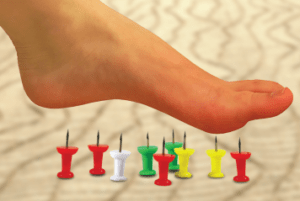
Recently Diagnosed or Relapsed? Stop Looking For a Miracle Cure, and Use Evidence-Based Therapies To Enhance Your Treatment and Prolong Your Remission
Multiple Myeloma an incurable disease, but I have spent the last 25 years in remission using a blend of conventional oncology and evidence-based nutrition, supplementation, and lifestyle therapies from peer-reviewed studies that your oncologist probably hasn't told you about.
Click the orange button to the right to learn more about what you can start doing today.
- You are here:
- Home »
- Blog »
- Multiple Myeloma »
- Multiple Myeloma-BIPN aka Nerve Damage
Multiple Myeloma-BIPN aka Nerve Damage

“The reported incidence of bortezomib-induced peripheral neuropathy (BIPN) ranges from 25 to 75 % (among MM patients).
This marks the fifteenth time I’ve written about chemotherapy/bortezomib-induced peripheral neuropathy (CIPN-BIPN). It’s not that I enjoy writing about CIPN so much but rather I come across studies documenting therapies that may be able to prevent or even health this debillitating, painful side offect of chemotherapy.
And I believe that CIPN is one of the most wide-spread, painful, debillitating side effects of multiple myeloma treatment there is.
The good news is that there are now more than a dozen therapies to either/or prevent or heal CIPN. The bad news is that BIPN is still a wide-spread, debilatating side effect of bortezomib for multiple myeloma patients.
The good news/bad news aspect of BIPN is that MM survivors have a broad spectrum of therapies to choose from. None of which is a silver bullet cure. My guess is that each MM patient must work at his/her supplementation as well as exercise, yoga, etc. to manage his/her nerve pain.
Have you been diagnosed with multiple myeloma? Are you about to undergo bortezomib? Scroll down the page, post a question or comment to learn more about nerve damage therapies.
Thank you,
David Emerson
- MM Survivor
- MM Cancer Coach
- Director PeopleBeatingCancer
Recommended Reading:
- Living w/ Post-Cancer Fear As a Myeloma Survivor-
- Organic Diet-Fewer Cancer Dx’s, Longer Cancer Survival
- Multiple Myeloma- PTSD- Manage Short, Long-term and Late Stage Health
Glutathione Ameliorates Bortezomib (Velcade) -Induced Neuronal Toxicity in N2a and SHSY5Y Cells
“Peripheral nerve damage is one of the most significant nonhematologic toxicities of bortezomib. The reported incidence of bortezomib-induced peripheral neuropathy (BIPN) ranges from 25 to 75 % . When it occurs, the painful sensory neuropathy can interfere with quality of life (QOL) and with performance of activities of daily living, and it may also adversely affect clinical outcomes by forcing dose modification and/or premature treatment discontinuation…
Several small randomized trials have addressed the protective effect of GSH against chemotherapy induced peripheral neuropathy (CIPN )with a platinum agent…
In this study we observed that treatment of GSH either in the pre-treatment or in the post treatment inhibited the bortezomib -induced neuronal cell death in both mouse neuronal cells (N2a) as well as dopaminergic neuron of human origin (SHSY5Y)…
This research suggests that GSH ameliorates BIPN and thus can improve the QOL and increase the survival rate of patients treated with bortezomib…”
Impact of Somatic Yoga and Meditation on Fall Risk, Function, and Quality of Life for Chemotherapy-Induced Peripheral Neuropathy Syndrome in Cancer Survivors
“Quantitative findings. Significant improvements were found in flexibility (SR; P = .006); balance (FR; P = .001) and fall risk (TUG; P = .004). PNQ improved significantly (P = .003) with other measures improving non-significantly.
Qualitative findings. Five themes emerged:
- vacillation of CIPN pain perception over time;
- transferability of skills to daily activities;
- improvement in physical function;
- perceived relaxation as an effect of SYM; and
- group engagement provided a social context for not feeling isolated with CIPN.
Conclusion. Preliminary data suggest SYM may improve QOL, flexibility, and balance in cancer survivors with CIPN, with a fully powered randomized controlled trial indicated…
Chemotherapy induced peripheral neuropathy (CIPN) is a prevalent side effect of certain commonly used chemotherapies and reduces quality of life (QOL) in individuals diagnosed with cancer, including breast, colon, and lung cancer and lymphoma.1
CIPN is a particularly essential adverse effect to address because the importance of curing the cancer limits the ability to reduce the serious, long-lasting, and even permanent debility that may result. In addition, the pharmacological agents used for pain have negative side effects on balance.2–4 Unfortunately, CIPN cannot be prevented, and research has focused on pharmacological therapies aimed at reducing CIPN pain, which does not treat the loss of sensation and motor weakness.
The incidence of CIPN varies by the type of chemotherapeutic agent(s), the total dose, and patient-related factors such as race and genomics…5–10
Yoga and meditation as a combined intervention is often used by cancer survivors for symptom management, and a recent systematic review of randomized controlled trials (RCTs) showed that these combination interventions have strong beneficial effects on the QOL of oncological patients.16,17
Several studies demonstrate the positive effects of yoga with meditation on pain, sleep, fatigue, biomarkers,18 and QOL in cancer survivors.19,20 The Society of Integrative Oncology guidelines addressed the use of integrative therapies for the management of adverse treatment effects, and an American Society of Clinical Oncology (ASCO) expert panel endorsed yoga and meditation for stress management and depression or mood disorders and improved QOL.19
These studies informed the use of yoga for pain management in neuropathic pain. However, no study has rigorously investigated its effects on CIPN and the associated functional outcomes.21..
Theme 1: Vacillation of CIPN Pain Perception Over Time
Nine of the participants reported evolving neurogenic changes throughout the study. They indicated that the yoga practice resulted in new sensations of their hands and feet. All participants echoed sentiments that CIPN is a long-lasting side effect of treatment that was downplayed or ignored in medical visits…
Theme 2: Transferability of Skills Learned Throughout the Yoga Intervention to Daily Activities
Six participants found the instruction and practice in breath work an essential aspect of their daily lives as a skill to assist in self-management of symptom exacerbation, daily activities, and anxiety. Three participants opted to use the breathing exercises as a sleep aid, whereas the other 4 participants used it to alleviate stress. Of the 9 participants who completed the journals, 5 participants asked for community yoga classes to attend after the study was over for continued sustainability of improvements…
Theme 3: Improvement in Physical Function Leading to Improvement or Return to Various Work and Hobbies
Six participants reported an improvement in their balance and flexibility as a result of the yoga sessions. Three participants indicated more confidence in performing daily tasks (standing up, cleaning, showering) as a result of more stability and balance. Six found improvement in their sleep from the breathing techniques and yoga exercises…
Theme 4: Relaxation as an Effect of the Yoga and Meditation
Eight participants consistently reported relaxation after the group sessions and/or home practice and were able to perceive improvements throughout daily function. Application of yoga techniques for relaxation contained some aspect of breathing exercises as a tool to aid sleep and relaxation…
Theme 5: Group Engagement Provided a Social Context for Not Feeling Alone With CIPN
Nine participants indicated that they received “support” from the other trial participants, via validation of CIPN symptoms and cancer survivorship experience, with empathy, understanding, and support. Camaraderie was cultivated through group practice and, at times, was easier or more beneficial than home practice. Four indicated that they appreciated the acknowledgment of their CIPN symptoms and the long-standing impact on their function and QOL. Five participants expressed that the group dynamic allowed them to feel less alone with their pain/experience, whereas other participants truly understood the felt experience of CIPN more than friends or families…
Conclusion- Cancer survivors with CIPN have sensory and motor deficits leading to inappropriate proprioceptive feedback, impaired postural control, and fall risk. SYM may improve clinical measures and patient-reported symptoms in cancer survivors with CIPN. Although results should be interpreted cautiously because of the small sample size, this pilot trial has shown preliminary evidence that yoga and meditation with a focus on somatic awareness has positive therapeutic effects for cancer survivors with CIPN. This can enhance QOL and produce significant improvement in vibration sense and functional measures of flexibility, balance, and mobility outcomes. A fully powered, randomized clinical trial is needed to confirm these results.


